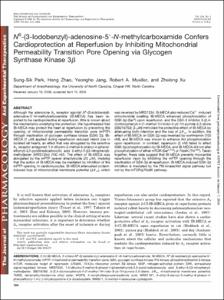KUMEL Repository
1. Journal Papers (연구논문)
1. School of Medicine (의과대학)
Dept. of Anesthesiology & Pain Medicine (마취통증의학)
N6-(3-Iodobenzyl)-adenosine-5 -N-methylcarboxamide Confers Cardioprotection at Reperfusion by Inhibiting Mitochondrial Permeability Transition Pore Opening via Glycogen Synthase Kinase 3β
- Keimyung Author(s)
- Jang, Young Ho
- Journal Title
- Journal of Pharmacology and Experimental Therapeutics
- Issued Date
- 2006
- Volume
- 318
- Issue
- 1
- Abstract
- Although the adenosine A3 receptor agonist N6-(3-iodobenzyl)-adenosine-5′-N-methylcarboxamide (IB-MECA) has been reported to be cardioprotective at reperfusion, little is known about the mechanisms underlying the protection. We hypothesized that IB-MECA may protect the heart at reperfusion by preventing the opening of mitochondrial permeability transition pore (mPTP) through inactivation of glycogen synthase kinase (GSK) 3β. IB-MECA (1 μM) applied during reperfusion reduced infarct size in isolated rat hearts, an effect that was abrogated by the selective A3 receptor antagonist 1,4-dihydro-2-methyl-6-phenyl-4-(phenylethynyl)-3,5-pyridinedicarboxylic acid 3-ethyl-5-[(3-nitrophenyl)-methyl]ester (MRS1334) (100 nM). The effect of IB-MECA was abrogated by the mPTP opener atractyloside (20 μM), implying that the action of IB-MECA may be mediated by inhibition of the mPTP opening. In cardiomyocytes, IB-MECA attenuated oxidant-induced loss of mitochondrial membrane potential (ΔΨm), which was reversed by MRS1334. IB-MECA also reduced Ca2+-induced mitochondrial swelling. IB-MECA enhanced phosphorylation of GSK-3β (Ser9) upon reperfusion, and the GSK-3 inhibitor 3-(2,4-dichlorophenyl)-4-(1-methyl-1H-indol-3-yl)-1H-pyrrole-2,5-dione (SB216763) (3 μM) mimicked the protective effect of IB-MECA by attenuating both infarction and the loss of ΔΨm. In addition, the effect of IB-MECA on GSK-3β was reversed by wortmannin (100 nM), and IB-MECA was shown to enhance Akt phosphorylation upon reperfusion. In contrast, rapamycin (2 nM) failed to affect GSK-3β phosphorylation by IB-MECA, and IB-MECA did not alter phosphorylation of either mTOR (Ser2448) or 70s6K (Thr389). Taken together, these data suggest that IB-MECA prevents myocardial reperfusion injury by inhibiting the mPTP opening through the inactivation of GSK-3β at reperfusion. IB-MECA-induced GSK-3β inhibition is mediated by the PI3-kinase/Akt signal pathway but not by the mTOR/p70s6K pathway.
It is well known that activation of adenosine A3 receptors by selective agonists applied before ischemia can trigger pharmacological preconditioning to protect the heart against ischemia/reperfusion injury (Tracey et al., 1997; Takano et al., 2001; Zhao and Kukreja, 2002). However, because pre-treatments are seldom possible in the clinical setting of acute myocardial infarction, it is important to determine whether A3 receptor activation after the onset of ischemia or during reperfusion can also confer cardioprotection. In this regard, Vinten-Johansen's group has reported that the selective A3 receptor agonist 2-CI-IB-MECA given at reperfusion protects isolated rabbit hearts by decreasing polymorphonuclear neutrophil-endothelial cell interactions (Jordan et al., 1997). Likewise, several recent studies have also shown a cardioprotective effect of A3 receptor activation with IB-MECA or 2-CI-IB-MECA upon reperfusion in rat (Maddock et al., 2002), guinea pig (Maddock et al., 2003), and dog (Auchampach et al., 2003) hearts. Nevertheless, curiously little is known about the cellular and molecular mechanisms that mediate the cardioprotection induced by A3 receptor activation at reperfusion.
Suleiman et al. (2001) and Weiss et al. (2003) have proposed that the opening of the mitochondrial transition pore (mPTP) plays an essential role in myocardial ischemia/reperfusion injury and that blockade of the pore opening is cardioprotective. Interestingly, it has been demonstrated that the mPTP remains closed during ischemia but opens at the onset of reperfusion (Griffiths and Halestrap, 1995) and that inhibition of mPTP opening at early reperfusion can protect the heart from reperfusion injury (Hausenloy et al., 2003; Halestrap et al., 2004). Because adenosine A3 receptor activation at reperfusion can exert cardioprotection against reperfusion injury, it is possible that IB-MECA applied at reperfusion may induce cardioprotection by modulating the opening of the mPTP. If this is the case, it is necessary to investigate the signaling mechanisms underlying the inhibition of the mPTP opening by IB-MECA. Inhibition of GSK-3β has been shown to contribute to opioid-induced cardioprotection at reperfusion (Gross et al., 2004) and serves as one important mechanism by which pharmacological preconditioning prevents the mPTP opening in cardiomyocytes (Juhaszova et al., 2004). GSK-3β has high basal activity and is activated by phosphorylation of its Tyr216 residue, whereas phosphorylation at Ser9 decreases its activity (Cohen and Frame, 2001). Some intracellular signals such as PI3-kinase/Akt, mTOR/p70s6K, and mitogen-activated protein kinases have been proposed to decrease GSK-3β activity by phosphorylating it (Cohen and Frame, 2001; Murphy, 2004). Because these signals may play an important role in cardioprotection against reperfusion injury (Hausenloy and Yellon, 2004) and stimulation of adenosine A3 receptors can activate Akt (Gao et al., 2001) and ERK (Schulte and Fredholm, 2003), it is possible that IB-MECA-induced cardioprotection at reperfusion may also be due to suppression of GSK-3β activity.
In this study, we examined whether IB-MECA given at reperfusion protects the heart by modulating mPTP opening via GSK-3β and to dissect the signaling mechanisms that mediate the protective effect of IB-MECA.
- Keimyung Author(s)(Kor)
- 장영호
- Publisher
- School of Medicine
- Citation
- Sung-Sik Park et al. (2006). N6-(3-Iodobenzyl)-adenosine-5 -N-methylcarboxamide Confers Cardioprotection at Reperfusion by Inhibiting Mitochondrial Permeability Transition Pore Opening via Glycogen Synthase Kinase 3β. Journal of Pharmacology and Experimental Therapeutics, 318(1), 124–131. doi: 10.1124/jpet.106.101477
- Type
- Article
- ISSN
- 0022-3565
- Appears in Collections:
- 1. School of Medicine (의과대학) > Dept. of Anesthesiology & Pain Medicine (마취통증의학)
- 파일 목록
-
-
Download
 oak-aaa-2589.pdf
기타 데이터 / 358.74 kB / Adobe PDF
oak-aaa-2589.pdf
기타 데이터 / 358.74 kB / Adobe PDF
-
Items in Repository are protected by copyright, with all rights reserved, unless otherwise indicated.